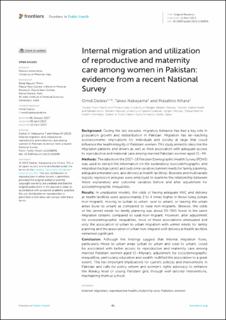| dc.contributor.author | Dadras, Omid | |
| dc.contributor.author | Nakayama, Takeo | |
| dc.contributor.author | Kihara, Masahiro | |
| dc.date.accessioned | 2023-08-15T12:16:15Z | |
| dc.date.available | 2023-08-15T12:16:15Z | |
| dc.date.created | 2023-06-02T14:39:47Z | |
| dc.date.issued | 2023 | |
| dc.identifier.issn | 2296-2565 | |
| dc.identifier.uri | https://hdl.handle.net/11250/3084158 | |
| dc.description.abstract | Background: During the last decades, migratory behavior has had a key role in population growth and redistribution in Pakistan. Migration has far-reaching socioeconomic implications for individuals and society at large that could influence the health integrity of Pakistani women. This study aimed to describe the migration patterns and drivers as well as their association with adequate access to reproductive and maternal care among married Pakistani women aged 15–49. Methods: The data from the 2017–18 Pakistan Demographic Health Survey (PDHS) was used to extract the information on the explanatory (sociodemographic and migration backgrounds) and outcome variables (unmet needs for family planning, adequate antenatal care, and delivery at health facilities). Bivariate and multivariate logistic regression analyses were employed to examine the relationship between these explanatory and outcome variables before and after adjustment for sociodemographic inequalities. Results: In unadjusted models, the odds of having adequate ANC and delivery at health facilities were approximately 2 to 4 times higher in those living (urban non-migrant), moving to (urban to urban, rural to urban), or leaving the urban areas (rural to urban) as compared to rural non-migrants; likewise, the odds of the unmet needs for family planning was about 20–50% lower in the same migration streams compared to rural non-migrant. However, after adjustment for sociodemographic inequalities, most of these associations attenuated and only the association of urban to urban migration with unmet needs for family planning and the association of urban non-migrant with delivery at health facilities remained significant. Conclusion: Although the findings suggest that Internal migration flows, particularly those to urban areas (urban to urban and rural to urban), could be associated with better access to reproductive and maternity care among married Pakistani women aged 15–49 years; adjustment for sociodemographic inequalities, particularly education and wealth, nullified this association to a great extent. This has important implications for current policies and interventions in Pakistan and calls for policy reform and women’s rights advocacy to enhance the literacy level of young Pakistani girls through well-tailored interventions, maintaining them at school. | en_US |
| dc.language.iso | eng | en_US |
| dc.publisher | Frontiers | en_US |
| dc.rights | Navngivelse 4.0 Internasjonal | * |
| dc.rights.uri | http://creativecommons.org/licenses/by/4.0/deed.no | * |
| dc.title | Internal migration and utilization of reproductive and maternity care among women in Pakistan: evidence from a recent National Survey | en_US |
| dc.type | Journal article | en_US |
| dc.type | Peer reviewed | en_US |
| dc.description.version | publishedVersion | en_US |
| dc.rights.holder | Copyright 2023 The Author(s) | en_US |
| dc.source.articlenumber | 1138898 | en_US |
| cristin.ispublished | true | |
| cristin.fulltext | original | |
| cristin.qualitycode | 1 | |
| dc.identifier.doi | 10.3389/fpubh.2023.1138898 | |
| dc.identifier.cristin | 2151333 | |
| dc.source.journal | Frontiers in Public Health | en_US |
| dc.identifier.citation | Frontiers in Public Health. 2023, 11, 1138898. | en_US |
| dc.source.volume | 11 | en_US |

